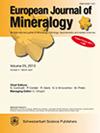刚玉(α-Al2O3)中二价阳离子羟基的振动特性
IF 1.7
3区 地球科学
Q2 MINERALOGY
引用次数: 0
摘要
摘要直接掺杂二价阳离子(Mg2+)或含有三价阳离子在H2气体中还原形成的二价阳离子(Co2+, Ni2+)的合成刚玉(α-Al2O3)样品的红外光谱在~ 3000 cm−1处显示出宽的OH拉伸带,这是由于在结构上掺入了微量的氢。从一些天然蓝宝石中记录的实验光谱显示出类似的吸收带,与3161 cm−1的主吸收有关,而一些铍扩散刚玉晶体显示出3060 cm−1的吸收带。所有这些波段在1900到2700 cm−1之间也显示出更小、更窄的波段,其性质定义不清。本文从密度泛函理论的角度研究了刚玉(α-Al2O3)中一系列OH缺陷的原子结构、相对稳定性和红外光谱特性。所研究的缺陷是由形成OH基团的间隙H+离子组成的,并补偿了与在邻近八面体位置上取代Al3+的二价阳离子(Be2+, Mg2+, Cr2+, Mn2+, Fe2+, Co2+, Ni2+)存在相关的电荷不平衡。实验光谱中出现在~ 3000 cm−1的波段被指定为这些缺陷的OH拉伸模式,而在1900和2700 cm−1附近观察到的波段被指定为相应OH弯曲模式的泛音。这些结果也支持了在一些红宝石和黄色蓝宝石的实验光谱中观察到的所谓的“3161 cm−1系列”的分配,即与Fe2+离子结合的OH结构基团,而不是先前提出的Si4+。从刚玉宝石数据库中提取的实验红外光谱波段区域之间的相关性分析也支持了这些推论。对中等强度氢键中OH基团的电不谐性与OH弯曲泛音带的异常强度和极化性质的关系进行了定性解释。本文章由计算机程序翻译,如有差异,请以英文原文为准。
Vibrational properties of OH groups associated with divalent cations in corundum (α-Al2O3)
Abstract. The infrared spectra of synthetic corundum (α-Al2O3) samples either doped directly with divalent cations (Mg2+) or containing divalent cations formed by reduction of trivalent cations in H2 gas (Co2+, Ni2+) may display broad OH stretching bands at ∼3000 cm−1 due to the structural incorporation of trace amounts of hydrogen. Experimental spectra recorded from some natural sapphires display a similar absorption band associated with a dominant absorption at 3161 cm−1, and some beryllium-diffused corundum crystals show a band at 3060 cm−1. All of these also display smaller and generally narrower bands between 1900 and 2700 cm−1, whose natures are poorly defined. In this work, the atomic-scale structure, relative stability and infrared spectroscopic properties of a series of OH defects in corundum (α-Al2O3) are theoretically investigated at the density-functional-theory level. The investigated defects consist of interstitial H+ ions forming OH groups and compensating for the charge imbalance related to the presence of divalent cations (Be2+, Mg2+, Cr2+, Mn2+, Fe2+, Co2+, Ni2+) substituted for Al3+ at nearby octahedral sites. Bands occurring at ∼3000 cm−1 in experimental spectra are assigned to the OH stretching modes of some of these defects, with bands observed around 1900 and 2700 cm−1 being assigned to overtones of corresponding OH bending modes. The results also support the assignment of the so-called “3161 cm−1 series”, observed in experimental spectra of some rubies and yellow sapphires, to structural OH groups in association with Fe2+ ions, rather than Si4+, as has been previously proposed. These inferences are also supported by analysis of correlations between band areas in experimental infrared spectra extracted from a database of corundum gemstones. A qualitative explanation relating the anomalous intensity and the polarisation properties of the OH bending overtone bands to the electrical anharmonicity of OH groups involved in medium-strength H bonds is proposed.
求助全文
通过发布文献求助,成功后即可免费获取论文全文。
去求助
来源期刊
CiteScore
2.80
自引率
9.50%
发文量
40
审稿时长
6-12 weeks
期刊介绍:
EJM was founded to reach a large audience on an international scale and also for achieving closer cooperation of European countries in the publication of scientific results. The founding societies have set themselves the task of publishing a journal of the highest standard open to all scientists performing mineralogical research in the widest sense of the term, all over the world. Contributions will therefore be published primarily in English.
EJM publishes original papers, review articles and letters dealing with the mineralogical sciences s.l., primarily mineralogy, petrology, geochemistry, crystallography and ore deposits, but also biomineralogy, environmental, applied and technical mineralogy. Nevertheless, papers in any related field, including cultural heritage, will be considered.

 求助内容:
求助内容: 应助结果提醒方式:
应助结果提醒方式:


